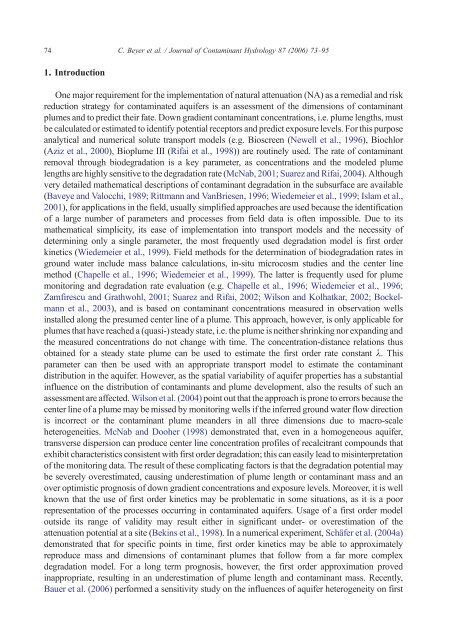Applied numerical modeling of saturated / unsaturated flow and ...
Applied numerical modeling of saturated / unsaturated flow and ...
Applied numerical modeling of saturated / unsaturated flow and ...
You also want an ePaper? Increase the reach of your titles
YUMPU automatically turns print PDFs into web optimized ePapers that Google loves.
74 C. Beyer et al. / Journal <strong>of</strong> Contaminant Hydrology 87 (2006) 73–95<br />
1. Introduction<br />
One major requirement for the implementation <strong>of</strong> natural attenuation (NA) as a remedial <strong>and</strong> risk<br />
reduction strategy for contaminated aquifers is an assessment <strong>of</strong> the dimensions <strong>of</strong> contaminant<br />
plumes <strong>and</strong> to predict their fate. Down gradient contaminant concentrations, i.e. plume lengths, must<br />
be calculated or estimated to identify potential receptors <strong>and</strong> predict exposure levels. For this purpose<br />
analytical <strong>and</strong> <strong>numerical</strong> solute transport models (e.g. Bioscreen (Newell et al., 1996), Biochlor<br />
(Aziz et al., 2000), Bioplume III (Rifai et al., 1998)) are routinely used. The rate <strong>of</strong> contaminant<br />
removal through biodegradation is a key parameter, as concentrations <strong>and</strong> the modeled plume<br />
lengths are highly sensitive to the degradation rate (McNab, 2001; Suarez <strong>and</strong> Rifai, 2004). Although<br />
very detailed mathematical descriptions <strong>of</strong> contaminant degradation in the subsurface are available<br />
(Baveye <strong>and</strong> Valocchi, 1989; Rittmann <strong>and</strong> VanBriesen, 1996; Wiedemeier et al., 1999; Islam et al.,<br />
2001), for applications in the field, usually simplified approaches are used because the identification<br />
<strong>of</strong> a large number <strong>of</strong> parameters <strong>and</strong> processes from field data is <strong>of</strong>ten impossible. Due to its<br />
mathematical simplicity, its ease <strong>of</strong> implementation into transport models <strong>and</strong> the necessity <strong>of</strong><br />
determining only a single parameter, the most frequently used degradation model is first order<br />
kinetics (Wiedemeier et al., 1999). Field methods for the determination <strong>of</strong> biodegradation rates in<br />
ground water include mass balance calculations, in-situ microcosm studies <strong>and</strong> the center line<br />
method (Chapelle et al., 1996; Wiedemeier et al., 1999). The latter is frequently used for plume<br />
monitoring <strong>and</strong> degradation rate evaluation (e.g. Chapelle et al., 1996; Wiedemeier et al., 1996;<br />
Zamfirescu <strong>and</strong> Grathwohl, 2001; Suarez <strong>and</strong> Rifai, 2002; Wilson <strong>and</strong> Kolhatkar, 2002; Bockelmann<br />
et al., 2003), <strong>and</strong> is based on contaminant concentrations measured in observation wells<br />
installed along the presumed center line <strong>of</strong> a plume. This approach, however, is only applicable for<br />
plumes that have reached a (quasi-) steady state, i.e. the plume is neither shrinking nor exp<strong>and</strong>ing <strong>and</strong><br />
the measured concentrations do not change with time. The concentration-distance relations thus<br />
obtained for a steady state plume can be used to estimate the first order rate constant λ. This<br />
parameter can then be used with an appropriate transport model to estimate the contaminant<br />
distribution in the aquifer. However, as the spatial variability <strong>of</strong> aquifer properties has a substantial<br />
influence on the distribution <strong>of</strong> contaminants <strong>and</strong> plume development, also the results <strong>of</strong> such an<br />
assessment are affected. Wilson et al. (2004) point out that the approach is prone to errors because the<br />
center line <strong>of</strong> a plume may be missed by monitoring wells if the inferred ground water <strong>flow</strong> direction<br />
is incorrect or the contaminant plume me<strong>and</strong>ers in all three dimensions due to macro-scale<br />
heterogeneities. McNab <strong>and</strong> Dooher (1998) demonstrated that, even in a homogeneous aquifer,<br />
transverse dispersion can produce center line concentration pr<strong>of</strong>iles <strong>of</strong> recalcitrant compounds that<br />
exhibit characteristics consistent with first order degradation; this can easily lead to misinterpretation<br />
<strong>of</strong> the monitoring data. The result <strong>of</strong> these complicating factors is that the degradation potential may<br />
be severely overestimated, causing underestimation <strong>of</strong> plume length or contaminant mass <strong>and</strong> an<br />
over optimistic prognosis <strong>of</strong> down gradient concentrations <strong>and</strong> exposure levels. Moreover, it is well<br />
known that the use <strong>of</strong> first order kinetics may be problematic in some situations, as it is a poor<br />
representation <strong>of</strong> the processes occurring in contaminated aquifers. Usage <strong>of</strong> a first order model<br />
outside its range <strong>of</strong> validity may result either in significant under- or overestimation <strong>of</strong> the<br />
attenuation potential at a site (Bekins et al., 1998). In a <strong>numerical</strong> experiment, Schäfer et al. (2004a)<br />
demonstrated that for specific points in time, first order kinetics may be able to approximately<br />
reproduce mass <strong>and</strong> dimensions <strong>of</strong> contaminant plumes that follow from a far more complex<br />
degradation model. For a long term prognosis, however, the first order approximation proved<br />
inappropriate, resulting in an underestimation <strong>of</strong> plume length <strong>and</strong> contaminant mass. Recently,<br />
Bauer et al. (2006) performed a sensitivity study on the influences <strong>of</strong> aquifer heterogeneity on first

















